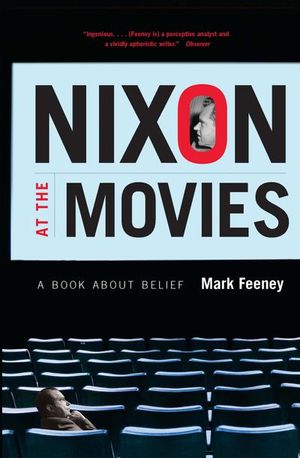Nixon at the Movies
Published by The University of Chicago Press
“People will be arguing over Nixon at the Movies as much as, for more than half a century, the country at large has been arguing about Nixon.”—Greil Marcus
Richard Nixon and the film industry arrived in Southern California in the same year, 1913, and they shared a long and complex history. The president screened Patton multiple times before and during the invasion of Cambodia, for example. In this unique blend of political biography, cultural history, and film criticism, Mark Feeney recounts in detail Nixon’s enthusiastic viewing habits during his presidency, and takes a new and often revelatory approach to Nixon’s career and Hollywood’s, seeing aspects of Nixon’s character, and the nation’s, refracted and reimagined in film. Nixon at the Movies is a “virtuosic” examination of a man, a culture, and a country in a time of tumult (Slate).
“By Feeney's count, Nixon, an unabashed film buff, watched more than 500 movies during the 67 months of his presidency, all carefully listed in an appendix titled ‘What the President Saw and When He Saw It.’ Nixon concentrated intently on whatever was on the screen; he refused to leave even if the picture was a dud and everyone around him was restless. He was omnivorous, would watch anything, though he did have his preferences…Only rarely did he watch R-rated or foreign films. He liked happy endings. Movies were obviously a means of escape for him, and as the Watergate noose tightened, he spent ever more time in the screening room.”—The New York Times
Richard Nixon and the film industry arrived in Southern California in the same year, 1913, and they shared a long and complex history. The president screened Patton multiple times before and during the invasion of Cambodia, for example. In this unique blend of political biography, cultural history, and film criticism, Mark Feeney recounts in detail Nixon’s enthusiastic viewing habits during his presidency, and takes a new and often revelatory approach to Nixon’s career and Hollywood’s, seeing aspects of Nixon’s character, and the nation’s, refracted and reimagined in film. Nixon at the Movies is a “virtuosic” examination of a man, a culture, and a country in a time of tumult (Slate).
“By Feeney's count, Nixon, an unabashed film buff, watched more than 500 movies during the 67 months of his presidency, all carefully listed in an appendix titled ‘What the President Saw and When He Saw It.’ Nixon concentrated intently on whatever was on the screen; he refused to leave even if the picture was a dud and everyone around him was restless. He was omnivorous, would watch anything, though he did have his preferences…Only rarely did he watch R-rated or foreign films. He liked happy endings. Movies were obviously a means of escape for him, and as the Watergate noose tightened, he spent ever more time in the screening room.”—The New York Times
BUY NOW FROM
COMMUNITY REVIEWS

